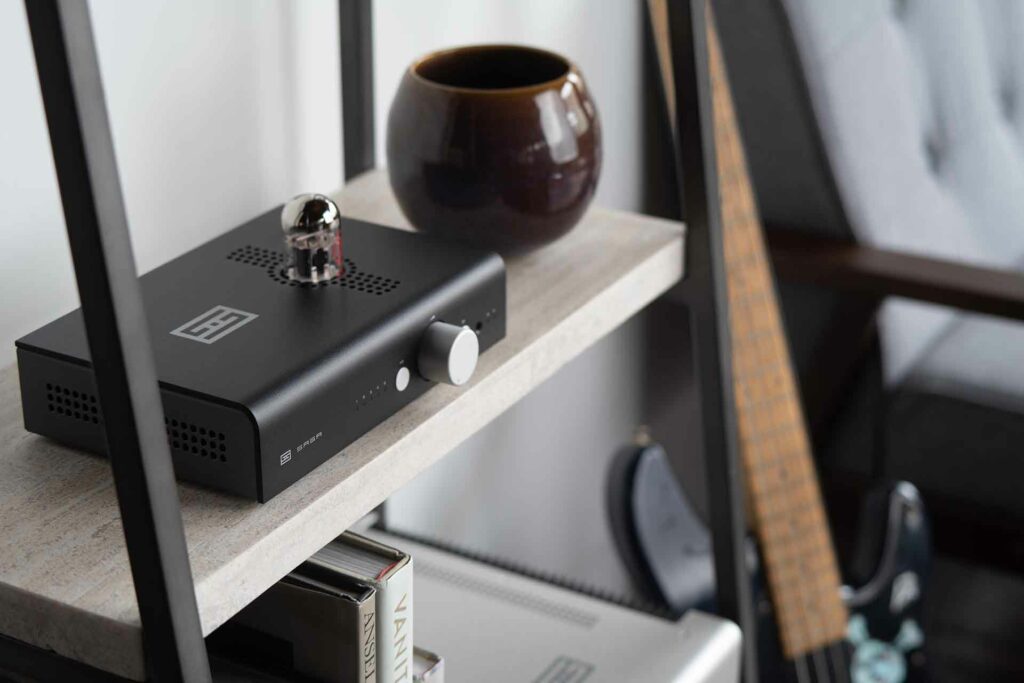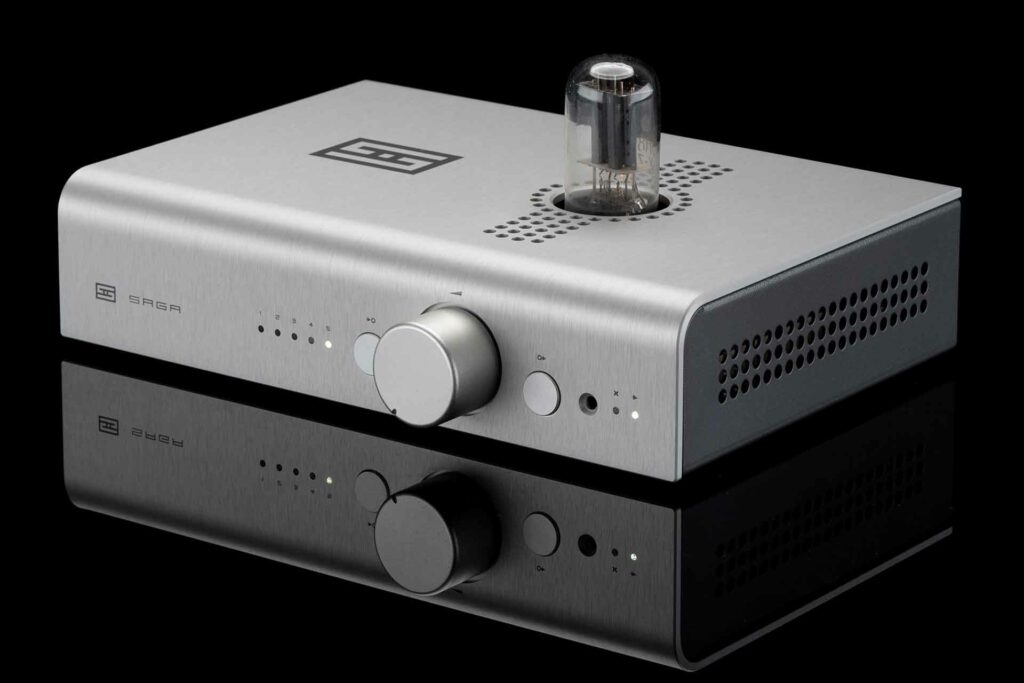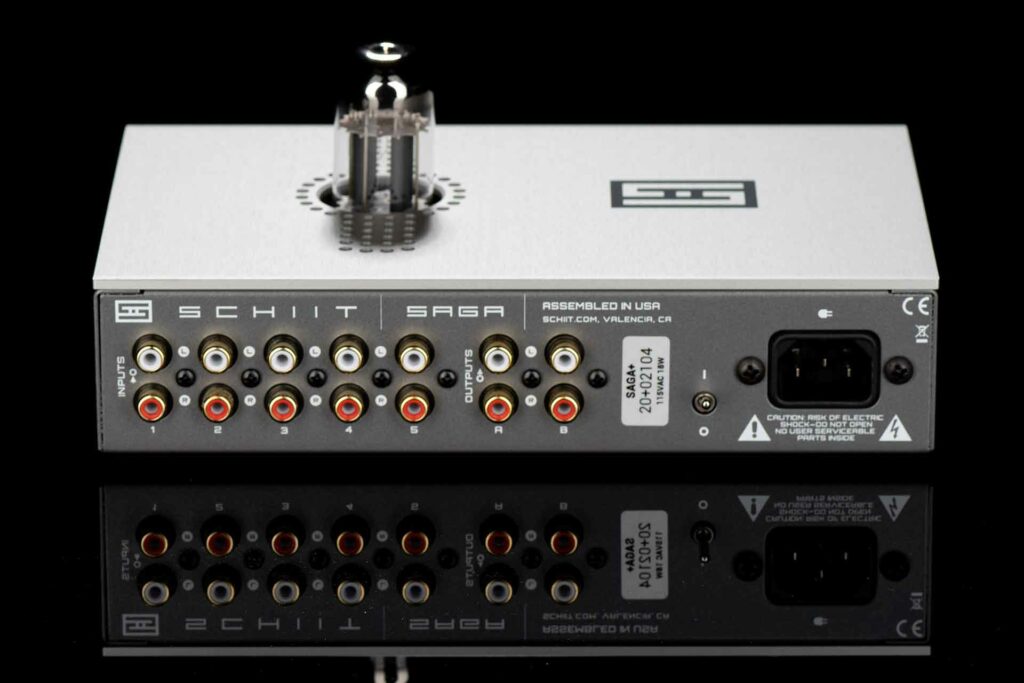Some folks prefer a tube-based preamplifier in their audio system while others prefer a solid-state preamplifier. By tube-based, I mean an audiophile preamplifier which uses a vacuum tube as its principal gain device. In contrast, a passive preamplifier attenuates the signal, but does not add gain even at its maximum level, which will be equal to the output level of the selected active source device. The beauty of the Schiit Saga+ preamplifier is that it has both. Priced at $399, the Schiit Saga+ is a very affordable way to get started in the world of tubes or even have a secondary system that embraces the warm sound of tubes without the cold feeling of going broke.

What Makes the Schiit Saga+ Stereo Preamplifier Special?
- Since it has both active and passive modes, the Schiit Saga+ can support an extremely wide range of source devices’ input levels and produce a wide range of output levels.
- The Schiit Saga+ supports five line-level single-ended RCA inputs and has two pairs of outputs. The double set of outputs makes it very easy to attach a subwoofer if you wish.
- As you might suspect, the two audio modes offer two different sonic perspectives. The first mode sounds straight, clean, and incisive with nothing added. The second mode is more of a big and bold sound, but also somewhat more forgiving of less-than-pristine recordings.
- The Saga+ comes with a well-designed, dedicated remote that handles all the basic preamp functions, including switching modes, mute, volume control, and source selection. Effective range and angles of acceptance are excellent, and the remote even has a magnetized back that lets it stick to metal surfaces.
- The Saga+ has the same three-quarter-width size, shape, and styling as the Schiit Modius DAC and Schiit Magnius headphone amplifier. They stack nicely as long as the Saga+ is on top (due to the tube).
Why Should You Care About the Schiit Saga+ Preamplifier?
I love my Schiit Freya S preamplifier (read the review), but some of my audio systems don’t require balanced inputs and outputs since they use only single-ended RCA-type connections. In that situation, the Schiit Saga S preamp would serve me just as well. Same with the Schiit Freya + compared to the Saga +. If you don’t require balanced XLR connections, you can save yourself $450 by purchasing the Saga+.
The Saga+ weighs substantially more than you would guess by looking at it. The heft is due in part to the case, as well as the substantial dual-transformer design. Pictures on their website of the Saga+ interior shows the high-quality parts, including Wima capacitors and Nichicon resistors. I’ve looked inside a lot of high-priced, high-performance electronics, and the Saga+ gives up nothing in terms of build quality in comparison to most I’ve seen. I care about that.

Some Things You Might Not Like About the Schiit Saga+ Preamplifier
- Although the Saga+ has five analog inputs, it lacks a dedicated phono input. For a phono source, you will still need a dedicated phono preamplifier. Schiit makes one called the Schiit Mani 2, and Michael Zisserson has reviewed it on FutureAudiophile.com. It costs well under $300.
- Because the tube in the Schiit Saga+ is located so it sticks up above the top plane of the chassis, you can’t stack other components on top of it. It must, due to its protruding tube, be at the top of your component rack.
- If your cables are the premium variety with extra-large hardware, you might find the spaces between the RCA connections in the back of the Schiit Saga+ could be somewhat of a tight fit.
- When you switch from passive to active, if you do not readjust the volume downwards you could cause damage to your speakers. Active mode is much higher gain than passive mode. Schiit even programs a delay on the switch-over from passive to active to give you time to readjust your volume settings. Several times I forgot. It got very loud.
Listening to the Schiit Saga+ Preamplifier…
Glenn Gould’s last recording of Bach’s Goldberg Variations has been a longtime favorite of mine. Sony just released a new recording of outtakes and snippets from these sessions, along with recollections from Richard Einhorn, who was the producer on the album. Listening to the 44.1/16 version on Qobuz through the Saga+ in passive mode I could hear all the subtleties of Gould’s version as well as all the inhalations and exclamations that went along with his playing. If you think all classical music is boring, you need to hear Glenn Gould.
Sam Bush’s latest release, Radio John: Songs of John Hartford, consists of ten covers of John Hartford’s best songs. From the silliness of “Granny Wontcha Smoke Some Marijuana” to the sublime beauty of “A Simple Thing as Love,” Bush does Hartford’s compositions justice. On the 96/24 version on Qobuz, you can appreciate the excellent recording quality. Sam Bush’s vocals take centerstage, and while beginning to show some road wear, which you can hear, his phrasing and musical timing remain impeccable. I found the Schiit Saga+’s tube mode gave this recording a bit more kick, but the passive mode was still my preference.
Molly Tuttle’s Crooked Tree originally came out in April 2020. Now there’s a deluxe edition that has four bonus tracks, including a cover of the Grateful Dead’s “Dire Wolf.” The 96/24 Qobuz version sounds really good – her vocals sound gloriously unprocessed and each instrument in the mix is easy to listen to with exceedingly natural tonal balance. On the live version of “Dooley’s Farm,” I preferred Saga+ tube mode, but on rest of the album I once more gravitated to the passive mode.
Does the Schiit Saga+ Preamplifier Have Any Resale Value?
Yes. I see Schiit audio gear regularly priced at 60 to 80 percent of original retail, which is very high for any audiophile component. It helps that Schiit offers a five-year warranty and – for U.S. customers – fast domestic repair. Given all its features, unless you decide to go to fully balanced XLR connections instead of single-ended RCA, it’s hard to imagine outgrowing the Saga+. The prices are low to start and the value proposition is high. The Schiit fan base is real. You aren’t going to lose much money owning any Schiit component, realistically.

Who Is the Competition for the Schiit Saga+ Audiophile Preamplifier?
While there are over 125 “analog preamplifiers” listed on Amazon, none had quite the same feature set as the Saga+. Many have built-in digital-to-analog converters, which the Saga+ lacks, but many of these preamps lack analog inputs, so they don’t serve the same purpose. One purely analog preamplifier is the Topping Pre90 ($599 read the review). The Pre90 is pricier than the Schiit Saga+ but it offers balanced as well as single-ended inputs and outputs. The downsides of the Topping are its terrible remote, and it only supports one pair of single-ended RCA and one pair of balanced XRL inputs (you can get an extender box, but it costs an extra $250).
If you only require one analog input besides a dedicated phono, the Music Hall pa2.2 ($449) might be another possible option. It has a built-in phono input for both moving coil and moving magnet cartridges and one line-level analog input. It also has a built-in analog-to-digital convertor connected to a USB output so you can digitize any analog source you play through it. For analog outputs, it has one pair of fixed-level and one pair of variable outputs, both single-ended only.
As far as tube-based preamplifiers go, most U.S.-made (or U.S.-assembled) offerings are in far higher price categories than the Schiit Saga+. There are, however, plenty of tube-based preamplifiers being made and marketed by Chi-Fi or Chinese sources. I have linked to a retailer’s page where you can get an idea of the variety available. I’ve tried a few, including this one, based on a Marantz 7 circuit. It only has a single input and output, and needs better tubes, but it does sound quite nice, although not as quiet or tonally linear as the Saga+.

Final Thoughts on the Schiit Saga+ Preamplifier…
The Schiit Saga+ analog preamplifier has a special set of features that can’t be found on any other device at a similar price. Not only does it have well-though-out features, it’s also cleverly designed with high-quality components. Sonically, it gives you the sound of two different preamplifiers, which is not something you find in many other offerings.
Personally, I used the passive mode far more than the active tube mode, because I preferred the more linear, lower-gain option’s clarity and transparency, which was especially good at retaining delicate and subtle spatial cues. The tube mode was most useful for me when I was listening to commercial rock and pop recordings that tended to sound a little harsher. The tube mode made it more enjoyable to rock on if it wasn’t as accurate, which is the technically stated goal of any audiophile preamp.
At one time there was a chewing gum advertised heavily on TV that was “Two gums in one!” There was another gum that claimed to “Double your pleasure and double your fun!” The Schiit Saga+ preamplifier does both, and more, at a price that pretty much any audiophile can afford.



